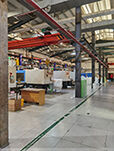در صنایع که در آن یکپارچگی محصول قابل مذاکره نیست، از مواد غذایی و داروسازی گرفته تا مواد شیمیایی و سوخت، سطل های پلاستیکی ضد نشت قهرمانان ناشناخته هستند.اما چه چیزی باعث می شود این ظروف در برابر ریزش و نفوذ مقاوم باشندبیایید به دنیای پیچیده طراحی، مواد و تولید که اطمینان می دهد سطل های پلاستیکی در شرایط مختلف آبپاش باقی می مانند، غوطه ور شویم.
در قلب هر سطل پلاستیکی قابل اعتماد، ساختاری با دقت طراحی شده است.ساخت و ساز دو دیواری، یک ویژگی مشترک در مدل های پیشرفته، یک منطقه خنک کننده ایجاد می کند که خطر گسترش ترک ها را از اثرات خارجی به حداقل می رساند.آزمایشات نشان می دهد که سطل های دارای دیوارهای دوگانه می توانند ۳۰٪ فشار بیشتری را در مقایسه با همتایان یک دیواری تحمل کنند.
درطراحی دوارهمچنین مهم است. رشته های قالب بندی شده دقیق در لبه سطل به طور یکپارچه با پوشش متصل می شوند و فشار مهر و موم را به طور مساوی توزیع می کنند.شبیه سازی های کامپیوتری پیشرفته به بهینه سازی ارتفاع و عمق رشته کمک می کند، اطمینان از یک تناسب محکم که در طول حمل و نقل در برابر پیچ و خم یا شل شدن مقاومت می کند.
انتخابمواد مهر و موممقاومت خروجی یک سطل را تعیین می کند.لاستیک EPDMگاسکت ها، ساخته شده از مونومر اتیلن پروپیلن دیئن، مقاومت شیمیایی و انعطاف پذیری عالی دارند. آنها می توانند نوسانات دمایی از -40 °C تا 150 °C را تحمل کنند.حفظ مهر و موم محکم حتی در شرایط شدید.
با این حال،بسته های سیلیکونیدر یک مطالعه اخیر مشخص شد که مهر و موم های سیلیکونی در مقایسه با لاستیک استاندارد، نشت را 98 درصد کاهش می دهند.به لطف کم فشرده سازی آنها (تغییرات کمتر در طول زمان) و مقاومت بیشتر در برابر تخریب UVاین باعث می شود آنها را برای ذخیره سازی در فضای باز یا استفاده طولانی مدت ایده آل کند.
سطل های ضد نشت در کارخانه های مجهز بهدستگاه های قالب دهی تزریقی با دقت بالااین ماشین ها دمای ذوب، سرعت تزریق و زمان خنک شدن را با دقت در سطح میکرو کنترل می کنند. به عنوان مثال، یک انحراف 1 °C در دمای ذوب می تواند باعث ضخامت غیر مساوی دیوار شود.که به طور بالقوه از یکپارچگی سطل آسیب می بیند..
بعد از توليد، هر سطل از طريق سختيآزمایش فشار. در یکآزمایش هیدروستاتیک، ظروف با آب پر می شوند و با فشار دو تا سه برابر از فشار عادی کار می کنند. هر گونه نشت باعث رد فوری می شود و اطمینان حاصل می شود که فقط محصولات بی نقص به بازار می رسند.
آزمایشات آزمایشگاهی مستقل علم پشت سطل های ضد نشت را تأیید می کنند. مطالعه ای که توسط موسسه تحقیقات بسته بندی انجام شد نشان داد:
-
سطل هایی با گاسکت های سیلیکونی تحت فشار 50 psi (پوند در هر اینچ مربع) ، معادل یک ستون آب 10 متری، مهر و موم را حفظ می کردند.
-
سطل های دو طرفه با دوار های تقویت شده نشت های مرتبط با برخورد را در مقایسه با طرح های استاندارد 65٪ کاهش می دهند.
این اعداد اهمیت طراحی، مواد و تولید را در ارائه عملکرد قابل اعتماد برجسته می کنند.
در حالی که صنایع از استانداردهای بالاتر برای ایمنی و پایداری تقاضا می کنند، علم پشت سطل های پلاستیکی ضد نشت همچنان در حال تکامل است.پلیمرهای خودشکنومهر های هوشمنددر افق قرار دارند، و وعده حفاظت بیشتر از محتوای ارزشمند را می دهند.
این که آیا شما مواد شیمیایی خطرناک یا محصولات غذایی حساس را ذخیره می کنید، درک شگفتی مهندسی پشت سطل های ضد نشت شما را قادر می سازد تا انتخاب های آگاهانه ای را انجام دهید.در دنیای بسته بندی، يه قطره علم ميتونه از يه طوفان از مشکلات جلوگيري کنه

 پیام شما باید بین 20 تا 3000 کاراکتر باشد!
پیام شما باید بین 20 تا 3000 کاراکتر باشد! لطفا ایمیل خود را چک کنید!
لطفا ایمیل خود را چک کنید!  پیام شما باید بین 20 تا 3000 کاراکتر باشد!
پیام شما باید بین 20 تا 3000 کاراکتر باشد! لطفا ایمیل خود را چک کنید!
لطفا ایمیل خود را چک کنید! 

